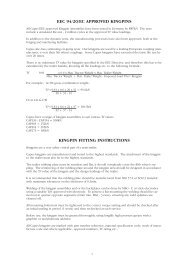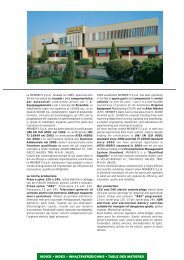COMMERCIAL VEHICLES - Capus UK Ltd
COMMERCIAL VEHICLES - Capus UK Ltd
COMMERCIAL VEHICLES - Capus UK Ltd
You also want an ePaper? Increase the reach of your titles
YUMPU automatically turns print PDFs into web optimized ePapers that Google loves.
EN<br />
I N T R O D U C T I O N<br />
Air Suspension Maintenance<br />
Vehicle Check-List<br />
• Check air lines and fi ttings for leaks: rubbing on air spring.<br />
• Check for proper clearance around air spring when infl ated. Generally, a minimum of 36 mm will allow for the increased<br />
diameter which occurs in heavy jounce.<br />
• Periodically, check suspension for proper ride height. This dimension should be maintained +/- 7 mm to protect the springs<br />
and shocks from over-extension or frequent bottoming out of the suspension.<br />
• When doing routine vehicle maintenance, block up the suspension and check for irregular wear or material build-up on the<br />
fl exmember. Clean, if necessary, using a non-petroleum based cleaning solution.<br />
• Check rolling lobe piston for material build-up. Hardened debris on the piston will shorten spring life and should be removed<br />
as part of your regular maintenance.<br />
• Check shock absorbers for any signs of leaking hydraulic fl uid, broken end connections, worn bushings or cylinders, over<br />
extension.<br />
• Periodically, check nuts and bolts for proper torque. See manufacturer’s manual for specifi c recommendations.<br />
• Check height control valve to see that it is functioning properly. Clean or replace, if necessary. A properly maintained valve<br />
will save hundreds of dollars in unneeded maintenance expense.<br />
• Routine inspection of all of the above, according to a pre-determined mileage maintenance schedule, will extend the life of<br />
your vehicle and reduce your overall maintenance expense.<br />
Air Spring Installation<br />
Before you start installing air springs, make sure you have all the necessary tools and equipment to perform the repair safely.<br />
Familiarize yourself with the suspension on which you are performing the repair by reviewing the manufacturer’s service guide.<br />
If you are in doubt about something, ask for assistance from a qualifi ed suspension specialist, the suspension manufacturer or the<br />
air spring manufacturer; it can save you a lot of time and aggravation later in the job.<br />
Here are important tips to remember when installing a new unit:<br />
• When disconnecting the leveling valve linkage, check for bent or broken linkage; if you fi nd any, replace the damaged parts.<br />
• Check shock absorbers for possible replacement. There are usually two warning signs indicating a worn shock. If it can be<br />
easily compressed or extended, it’s time for a new unit. Also, if the vehicle has just been brought in for service, the shock<br />
should be warm to the touch. If not, it needs to be replaced. Remember, proper shock maintenance is one of the keys to long<br />
air spring life.<br />
• Once the air lines are disconnected, check their entire length for cracks or other damage. Also check fi ttings for looseness<br />
and, of course, replace any worn components.<br />
• Sometimes the cause of air spring failure is visible and / or readily apparent; other times it’s not. When it isn’t, inspect the air<br />
spring after you have removed it to determine the cause of failure and then correct the root cause of the problem.<br />
• With the air spring removed, other parts of the air suspension become more accessible. Check for wear or damage of the<br />
frame hangers, trailing arm bushings, torque rods, the trailing arms and the air spring mounts. Again, replace components<br />
where necessary.<br />
• Also check the area around the air<br />
spring mounting to ensure there<br />
aren’t any obstacles or sharp edges es<br />
that can damage the new air spring.<br />
• Before installing the new unit, clean<br />
the air spring mounting plates to<br />
ensure proper attachment to the<br />
suspension.<br />
• Always use new attaching bolts for<br />
the installation. Old bolts should<br />
never be reused since they may fail.<br />
• Check the leveling arm for proper r<br />
operation. Under load, the leveling<br />
arm should move from the neutral<br />
position up to the intake position.<br />
This lets air into the springs, which<br />
brings the arm back to the neutral<br />
position. When the load is removed, ed,<br />
the leveling arm should move down<br />
to the exhaust position. Thatopens<br />
the exhaust valve, allowing air to<br />
escape until the arm returns to the<br />
neutral position.<br />
8






